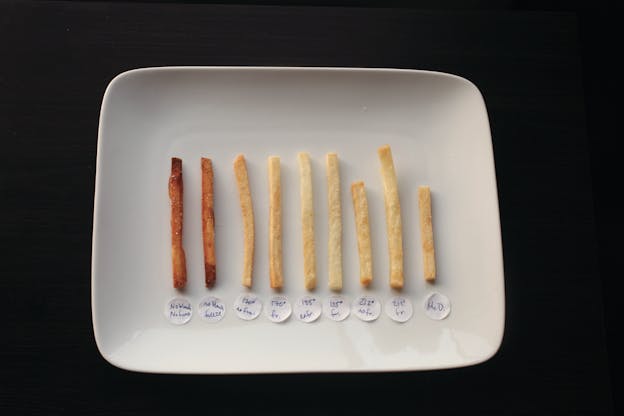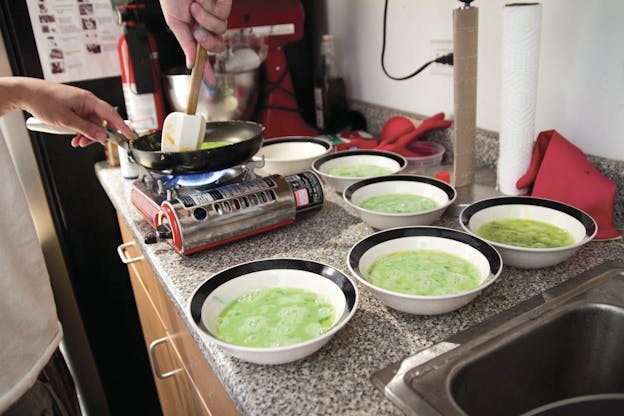
Even the most elaborate cookbooks usually have pretty modest aims: to make us less forgetful or more adventurous. Some of the earliest recipe collections—like The Forme of Cury, a 14th-century scroll—were not much more than aids to memory, listing ingredients and roughly the order in which they should be thrown together. Later writers, such as Elizabeth David and M. F. K. Fisher in the mid-twentieth century, were more admired for their evocation of cuisines1 than for the precision of their instructions. The promise of perfect food, meanwhile—that is, food that has been prepared using optimized methods, arrived at both by rigorous scientific experimentation with each of the variables in a recipe, and by application of scientific knowledge about heat transfer, the way proteins act, the chemistry of an acidic sauce—is as recent as the last decade and the rise of blogging.
The foremost perfectionist among today’s cooks is J. Kenji Lopez-Alt. A graduate of MIT, he spent a decade or so working in restaurant kitchens before he started writing a column called “The Food Lab” for the website Serious Eats in 2009. The column’s tagline was “Unraveling the mysteries of home cooking through science,” and Lopez-Alt’s first post took on an appropriately fraught question in home cooking: how to cook “Perfect Boiled Eggs”2.
In the post, he determined which factors were not important (the pH of the water, whether the pot was covered or uncovered, etc) and those that were (time and temperature). Over the remaining 2000 words, Lopez-Alt mapped the “temperature timeline” of a boiling egg and helpfully annotated cross sections of eggs at different stages of cooking. His subsequent disquisitions on “the best” slow-cooked tomato sauce and chicken stock were equally precise and mesmerizing. They struck at the root of a mystery home cooks gloomily encounter all the time: Why doesn’t this taste as good as it should?
Lopez-Alt wasn’t the only chef-turned-writer searching for perfection through science. You could argue that his approach has somewhat lofty origins in molecular gastronomy, the style of cooking practiced by chefs such as Ferran Adria and Heston Blumenthal. These chefs used their knowledge of food science to develop new combinations of tastes and textures. As Lopez-Alt writes in his new book The Food Lab (based on his Serious Eats columns), “Restaurants that revel in using the science of cookery to come up with new techniques…are not just proliferating but”—like Adria’s restaurant elBulli—“are consistently ranked as the best in the world.” The book itself is a beautiful behemoth, at over 950 pages replete with images that range from food porn to the instructional and diagrammatic. With its white, minimalist cover it looks a lot like Modernist Cuisine, the six-volume guide to “laboratory-inspired” haute cuisine by former Microsoft executive Nathan Myrhvold, published to great fanfare in 2011.
Yet it makes more sense to see Lopez-Alt’s particular strain of perfectionism as a product of the internet. Unlike Myrhvold and Adria’s respective projects, “The Food Lab” wasn’t about creating new, impossible forms of unfood-like food, like transparent ravioli, or oak moss vapor—delicate operations, more or less limited to professional kitchens. Like many of his contemporaries, Lopez-Alt explains instead how to cook optimized versions of already familiar foods: potato hash, roast chicken, lasagna, and the like. He has more in common with contrarian food bloggers like L. V. Anderson, who debunked misconceptions about cooking in her Slate column “You’re Doing It Wrong”. He shares, too, the completist tendencies of Felicity Cloake, who combines the art of cooking with the art of aggregation in her Guardian series, “How to Cook the Perfect…” Every week, she compares a set of well-known recipes for a new dish, documenting her results with iPhone-quality photos. It’s an experimental method that yields generally trustworthy results, though of course it can only build on old methods.

The Food Lab’s vision of “better home cooking through science”—and, I would add, through the internet—is a convincing one. The illustrations in his book (and on the blog) are themselves strong evidence of the perfectibility of American food staples, whether they show a carefully-labeled spectrum of French fries, starting yellow and shading into brown, or various formulations of chicken stock, arrayed like a Pantone chart. Not only is the book a very valuable resource, it provides elegant proof that “making a perfect French fry is not as simple as dunking a potato in hot oil for a few minutes.” It’s as complex an undertaking as making a successful soufflé.
There are also plenty of photos meant as warnings, intended to avert the aspiring cook’s own mishaps. In the section on “The Science of Ground Meat”—a long section that will appeal to people who “hate to love to grill”—there is a memorably ugly picture of a hamburger, showing the results of salting ground beef before forming it into patties. “Salt will dissolve muscle proteins,” Lopez-Alt writes, “which subsequently cross-link, turning your burgers from moist and tender to sausage-like and springy.” Many people would have a hard time stating exactly what the difference is between hamburger and sausage meat, Lopez-Alt realizes. Earlier in the book, he explains that sausage is “ground meat to which enough salt has been added (about 1.5 percent of the weight of its meat) that the protein myosin has dissolved, allowing it to subsequently bind the meat together when the raw mixture is stirred.” This is more than fascinating: understanding what is happening the mixing bowl empowers the cook to try variations that won’t interfere with the crucial chemical processes.
It’s hard to imagine such scientifically detailed recipes originating from any source other than an obsessive blog. For all its wonders, food science has rarely been the ally of the home cook until recently. In the twentieth century food science was the handmaiden of big manufacturers of processed foods, who often got a head start on their technology from the military. While the home cook used real ingredients and traditional methods, food science gave us mac and cheese in a box. The Institute for Food Technologists still describes its work as “developing the safe, nutritious foods and innovative packaging that line supermarket shelves everywhere.” In other words, their members are focused on creating “food products”, which makes economic sense. Those products can be sold in stores at a markup to offset the cost of research and development, whereas there is no commercial value in researching how to get the center of a poached egg appetizingly viscose3—a result that can only last a few minutes between cooking and eating.


This kind of knowledge has long been the domain of the gourmet4. Food writers like Lopez-Alt embraced blogging’s lack of constraints in order to dissect and disseminate what they learned, examining every aspect of a recipe and sometimes writing thousands of words about a fairly simple dish—a boiled egg or grilled corn. His column, and now his book, fills in the gaps left by traditional recipe books, which often take a base of knowledge for granted and never have enough pictures. His food isn’t elBulli scaled down for the domestic cook; it’s more like a series of food-hacks scaled up for discerning millennials (who are more enthusiastic about cooking than their Gen X and Boomer parents).
This is both good and bad. Better cooking through science is one thing; I find it harder to agree that cooking is nothing more than science. The Food Lab sometimes suggests that the cultures we build around food and cooking are less important than the scientific principles that explain how cooking works. “We’re finally beginning to see cooking for what it truly is,” Lopez-Alt announces in his introduction: “a scientific engineering problem in which the inputs are raw ingredients and technique and the outputs are deliciously edible ingredients.” That can be a useful way of thinking about a difficult problem; it might give someone who always failed at baking the confidence to try a new approach. On the other hand, it reflects the tech utopianism that redefines our friendships, vacation photos, and reading habits as data.
Nor does thinking about ingredients as inputs and outputs in this way help us understand the meaning that food and cooking have in our society and in our individual lives. In their book The Perfect Meal: The Multisensory Science of Food and Dining, researcher Betina Piqueras-Fiszman and Charles Spence, a psychology professor at the University of Oxford, investigate how all the elements of a meal except the food can affect taste. They found that background music altered diners’ experiences, as did the name used to refer to a dish—“Coq au vin” instead of “Chicken in wine”, for example. Food may taste better too, when prepared by someone else. If the rituals of the table can enhance the dining experience, it’s worth hanging onto some of the rituals of the kitchen as well.
Of course, “perfect” food will look different to different people, depending on the cultural traditions they identify with and their personal tastes. The Food Lab shows us one version of perfection and exactly how to achieve it, which is not a small achievement. This book wouldn’t be complete without a paean to sous vide—a newish method of cooking that many top chefs are devoted to, but which has no place in my own private pantheon. Sous vide involves sealing food in a plastic pouch and submerging it in a water bath at a low temperature for an unusually long time. “Because the water bath is maintained at the final serving temperature of the meat,” Lopez-Alt writes, “there’s absolutely no way you can overcook it.” This is the chef at his most ecstatic. “[W]e’re talking perfect food here.”
Still, sous vide is both expensive (water baths cost upwards of $1000) and time-consuming to do at home. Lopez-Alt recommends jerry-rigging a beer cooler to reduce the costs, though that seems an accident-prone compromise. Plenty of people aren’t keen on the results either. When the critic John Lanchester cooked a chicken with a sous vide kit at home, he found the bird “so moist that its texture was almost jellied”:
[T]he flesh was a faint pink, and the chicken-explosion of flavor was overwhelming… My roast-chicken-obsessed children threw down their cutlery in protest after a single mouthful.
So what are the benefits of this method? Well, as Lopez-Alt laments in the same chapter, “cooked foods develop an internal bulls-eye pattern: perfectly cooked at the very center to increasingly overcooked as you move out to the edges.”
This, to me, doesn’t sound so bad. In fact, leafing through the book, I saw appetizing charred steaks with bloody centers; lasagnas with browned, bubbling edges and gently steamed pasta sheets inside; a slightly burnt chipolata. These unevenly-cooked dishes, I realized, were closer to my own definition of perfect. Though this might mean my tastes are less sophisticated, my ideal is not more modest. And Lopez-Alt has given me a new vocabulary for contemplating perfection. When I cook now, I think in terms of myosin, of Maillaird reactions, and, in a new context, of the “bulls-eye”.
- “To eat figs off the tree in the very early morning, when they have been barely touched by the sun, is one of the exquisite pleasures of the Mediterranean,” David wrote.
- The article wasn’t exhaustive: more thorough treatment would arrive five years later in his post “The Hard Truth About Boiled Eggs”.
- Of course, there is commercial value for restaurants in perfect poached eggs but, as Lopez-Alt points out in his introduction, he rarely had time to experiment methodically with cooking techniques when he was a restaurant chef.
- Harold McGee’s 1984 book On Food And Cooking: The Science And Lore Of The Kitchen did explore the scientific principles in play during cooking and laid the groundwork for a generation of scientifically-minded chefs, but is more like an encyclopedia than the half-lab report/half-recipe form pioneered by Lopez-Alt.